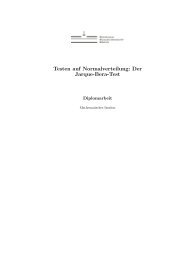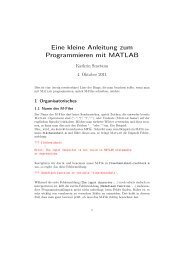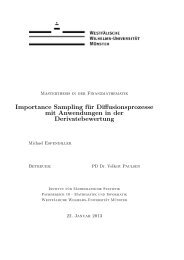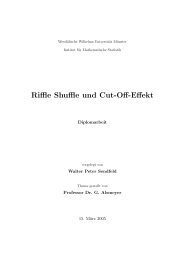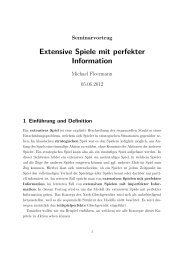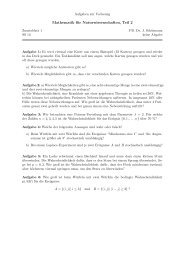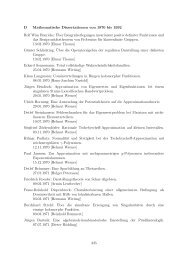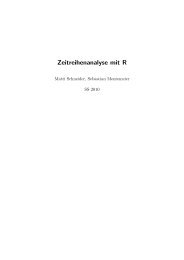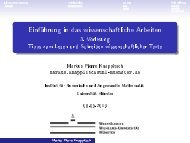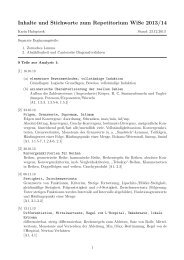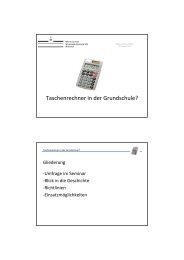Skript
Skript
Skript
Erfolgreiche ePaper selbst erstellen
Machen Sie aus Ihren PDF Publikationen ein blätterbares Flipbook mit unserer einzigartigen Google optimierten e-Paper Software.
We finally mention that any suitable linear regularization method can be applied<br />
to the Newton step, in particular also linear iterative methods such as<br />
Landweber iteration or conjugate gradient methods, leading to methods called<br />
Newton-Landweber or Newton-CG. The above decay of α k to zero corresponds<br />
to an increase of the inner iteration number in such cases.<br />
5.3 Iterative Methods als Zeit-Diskrete Flüße (time-discrete<br />
flows)<br />
Wir schließen diese Kapitel mit der Interpretation iterativer Regularisierungsmethoden<br />
als Zeit-Diskretisierung von Gradientenflüßen. We starten wieder mit<br />
der Landweber-Iteration die wir umschreiben als<br />
x k+1 − x k<br />
= −T ∗ (T x k − y)<br />
τ<br />
Wenn wir τ als Schrittweite und x k = x(kτ) als Zeitschritte eines Flußes interpretieren,<br />
dann entspricht die Landweber-Iteration einer expliziten (forwärts<br />
Euler) diskretisierung<br />
dx<br />
dt (t) = −T ∗ (T x(t) − y), (5.8)<br />
d.h. einer asymptotischen Regularisierung. Analog erhalten wir für das Newton-<br />
Verfahren<br />
x k+1 − x k<br />
= −F ′ (x k )(F (x k ) − y).<br />
τ<br />
underbrace<br />
dx<br />
dt (t) = −F ′ (x(t)) ∗ (F (x(t)) − y), (5.9)<br />
From this correspondance to the flow (5.9) it seems natural to try other time discretizations.<br />
The implicit time discretization (backward Euler) yields the nonlinear<br />
equation<br />
x k+1 − x k<br />
= −F ′ (x k+1 )(F (x k+1 ) − y),<br />
τ<br />
which is the optimality condition of the optimization problem<br />
‖F (x) − y‖ 2 + 1 τ ‖xk+1 − x k ‖ 2 → min<br />
x∈X ,<br />
well-known from Tikhonov regularization. The corresponding iterative procedure<br />
is therefore called iterated Tikhonov regularization. If we perform a semiimplicit<br />
time discretization, i.e., approximating F ′ (x) ∗ explicitely and F (x) by<br />
a first-order Taylor expansion around the last time step x k we end up with the<br />
Levenberg-Marquardt method. The iteratively regularized Gauss-Newton method<br />
corresponds to a non-consistent semi-implicit time discretization.<br />
From this motivation it is not surprising that general Runge-Kutta methods (even<br />
non-consistent ones) applied to the flow (5.9) yield convergent iterative regularization<br />
methods, as recently shown by Rieder [?].<br />
82



